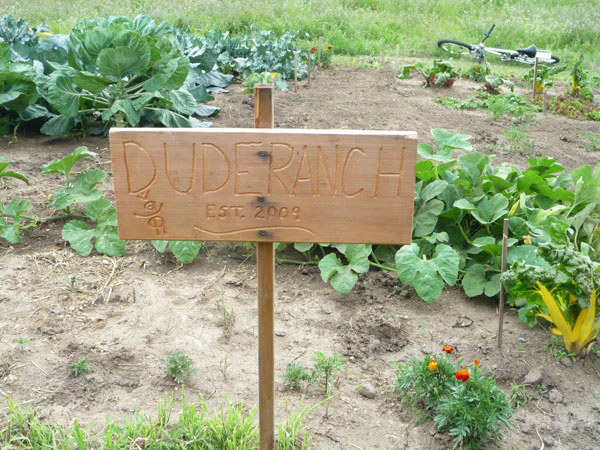
The office space for the public relations firm Haberman & Associates is located in downtown Minneapolis, but for the gardening season of 2009, the employees’ hearts, minds, and muscles can be more accurately pinpointed to a farm 30 miles west in Delano. That’s where, on the farm of Haberman executive Liz Morris Otto (above right), visitors can find the Dude Ranch, the firm’s first-year experiment in organic gardening. Haberman’s “office CSA” program is bringing together more than two-thirds of the firm’s 30 employees for a summer of raking, weeding, planting, and eating the bounty of their work — a model that they’re eager to see other companies emulate in the future.
“This is an innovative, low-cost way to benefit employees and the community,” says Fred Haberman (above left), who founded the firm with his wife, Sarah Bell Haberman. “Other companies are sure to create gardens when they see how easy it is.”
A business meeting with a CSA farmer last spring sparked the idea, which Haberman and Otto eagerly presented to staff four days later. With a client list that includes many local, organic, and / or sustainable food producers, Haberman employees enthusiastically embraced the concept.

“The original idea was to get a deeper understanding of organic farming and its challenges and obstacles,” says Otto, whom Haberman has deemed the “chief gardening officer.” “But it has bloomed into a fabulous benefit for employees.”
An office garden doesn’t run itself, however — organization is the key to creating a positive and productive experience for everyone involved. Haberman and Otto offer the following game plan for companies interested in nurturing their green thumbs:
- Find land. Otto’s farm provided the ideal space for a garden, but it’s not necessary to locate such a venture on an employee’s personal property. Companies with ample grounds can create a garden on site, or nearby municipal green space may be available with the right permit.

Jill Lewis / Heavy Table - Dedicate funding to the project. Even if much of the labor will be donated by employees, a garden still needs an initial financial investment to purchase seeds and equipment and pay for the water bill. You will also need to budget for outside help to take care of everyday maintenance (see step 4).
- Assess employee interest and determine a minimum level of participation. Decide how many people you’ll need to commit to working in the garden before you embark on the project. The Haberman team initially hoped for 10 employees to be regular contributors; 21 are currently on the active roster. You’ll also need to set expectations on the number of work sessions each member will undertake. Haberman set a minimum of three for throughout the season, but many employees have already gone beyond that number.
- Hire additional help. Though Haberman employees visit the garden two to three days each week, watering and other tasks need to be performed daily, so the firm hired two teenage helpers to tend to these tasks. “The garden can fall apart without hired help,” Otto says. “The boys identify the daily needs of the garden and have a good background knowledge of gardening.”
- Establish a ringleader. Otto took the lead in organizing the garden from the beginning, when she surveyed employees to discover which vegetables they were most interested in planting. She keeps a detailed tally of which crops have been planted and how much produce they harvest each week, and she also distributes a summary of tasks that need to be completed each week so her colleagues know what work has to be done.
- Create an internal and external communications plan. Weekly staff meetings at Haberman now include a garden update, and Otto also sends regular e-mail. The firm created a blog dedicated to the garden so employees and their families, clients, friends, and interested companies can keep track of its progress.
- Decide how to divvy up the harvest. All Haberman employees share in the produce, even those who don’t make it to the garden, but those who offer sweat equity get the first dibs. Employees who can’t physically work on the garden contribute in other ways, such as updating the garden blog and collecting recipes. Extra produce is donated to local food shelves and shared with clients.
- Call on outside resources. You don’t need a gardening savant among your colleagues to embark upon the project. Many people who are passionate about gardening and agriculture are happy to share tips. The Haberman crew has relied on guidance from Riverbend Farm owner Greg Reynolds, and the Wedge Co-op even offered potatoes to help get the garden started.
- Celebrate the bounty. Mark the fall harvest with a party to recognize all the hard work everyone put in over the summer. Haberman is planning “Dudestock” for September 26.
- Have fun! “Gardening can be overwhelming, especially for first-timers. We’ve been careful to stick to our goal of creating and sustaining a fun and educational team project. We’ve done this in a variety of ways, including creating a couple of funny and informative videos at the garden, inviting family and friends to participate, and allowing employees to choose their commitment level,” Otto says.

“Food unlocks people’s passion,” adds Haberman. “It’s been an unbelievably positive experience for our employees. The garden provides healthy food, instills pride among staff, and makes them more aware of food systems.”

Approach such executive-suggested, (possibly perceived as coerced) volunteerism with caution. Employees, especially Minnesotans, may say nothing yet still resent the pressure to spend their leisure time on an activity chosen by their boss.